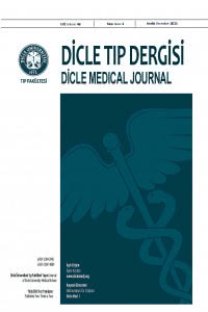Tükürük Bezi Tümörü Tanısında Ultrasonografi (USG), Mangnetik Rezonans Görüntüleme (MRG), Bilgisayarlı Tomografi (BT), İnce İğne Aspirasyon Biyopsisi’nin (İİAB) Karşılaştırılması
Comparison of Ultrasonography (USG), Mangnetic Resonance Imaging (MRI), Computed Tomography (CT) and Fine Needle Aspiration Biopsy (FNAB) for the Diagnosis of Salivary Gland Tumor
___
- 1.Mifsud MJ, Burton JN, Trotti AM, Padhya TA.Multidisciplinary management of salivary glandcancers. Cancer Control. 2016; 23: 242-8.
- 2.To VSH, Chan JYW, Tsang RK, Wei WI. Review ofsalivary gland neoplasms. ISRN otolaryngology.2012; 2012.
- 3.Mayland EJ, Pou AM. Evaluation and diagnosis ofsalivary gland neoplasms. Operative Techniques inOtolaryngology-Head and Neck Surgery. 2018; 29:129-34.
- 4.Özbay M, Şengül E, Topçu İ. Parotis kitlelerindetanı ve cerrahi tedavi sonuçları. 2016; 43: 315-18.
- 5. Guzzo M, Locati LD, Prott FJ, et al. Major and minorsalivary gland tumors. Critical reviews inoncology/hematology. 2010; 74: 134-48.
- 6.Farahani SJ, Baloch Z. Retrospective assessment ofthe effectiveness of the Milan system for reportingsalivary gland cytology: A systematic review andmeta‐analysis of published literature. Diagnosticcytopathology. 2019; 47: 67-87.
- 7.Kong X, Li H, Han Z. The diagnostic role ofultrasonography, computed tomography, magneticresonance imaging, positron emissiontomography/computed tomography, and real-timeelastography in the differentiation between benignand malignant salivary gland tumors: a meta-analysis. Oral Surgery, Oral Medicine, Oral Pathologyand Oral Radiology. 2019; 128: 431-43.
- 8.Araya J, Martinez R, Niklander S, Marshall M,Esguep A. Incidence and prevalence of salivary glandtumours in Valparaiso, Chile. Medicina oral,patologia oral y cirugia bucal. 2015; 20: e532.
- 9.Rajdeo RN, Shrivastava AC, Bajaj J, Shrikhande AV,Rajdeo RN. Clinicopathological study of salivary gland tumors: An observation in tertiary hospital of central India. Inter J Rese Med Sci. 2015; 3: 1691-6.
- 10.Song IH, Song JS, Sung CO, et al. Accuracy of coreneedle biopsy versus fine needle aspiration cytologyfor diagnosing salivary gland tumors. Journal ofpathology and translational medicine. 2015; 49:136.
- 11.Leelamma JP, Mohan BP. Spectrum of primaryepithelial tumors of major salivary glands: a 5 yearrecord based descriptive study from a tertiary carecentre. Int J Adv Med. 2017; 4: 5627.
- 12.Wahiduzzaman M, Barman N, Rahman T, et al.Major Salivary gland tumors: A Clinicopathologicalstudy. Journal of Shaheed Suhrawardy MedicalCollege. 2013; 5: 43-5.
- 13. Wang X-d, Meng L-j, Hou T-t, Huang S-h. Tumoursof the salivary glands in northeastern China: aretrospective study of 2508 patients. British Journalof Oral and Maxillofacial Surgery. 2015; 53: 132-7.
- 14.Vasconcelos AC, Nör F, Meurer L et al.Clinicopathological analysis of salivary glandtumors over a 15-year period. Brazilian oralresearch. 2016; 30.
- 15.Tian Z, Li L, Wang L, Hu Y, Li J. Salivary glandneoplasms in oral and maxillofacial regions: a 23-year retrospective study of 6982 cases in an easternChinese population. International journal of oral andmaxillofacial surgery. 2010; 39: 235-42.
- 16.Liu Y, Li J, Tan Y-r, Xiong P, Zhong L-p. Accuracyof diagnosis of salivary gland tumors with the use ofultrasonography, computed tomography, andmagnetic resonance imaging: a meta-analysis. Oralsurgery, oral medicine, oral pathology and oralradiology. 2015; 119: 238-45. e2.
- 17.Wu S, Liu G, Chen R, Guan Y. Role of ultrasoundin the assessment of benignity and malignancy ofparotid masses. Dentomaxillofacial Radiology. 2012; 41: 131-5.
- 18.Lee Y, Wong K, King A, Ahuja A. Imaging ofsalivary gland tumours. European journal ofradiology. 2008; 66: 419-36.
- 19.Milad P, Elbegiermy M, Shokry T, et al. The addedvalue of pretreatment DW MRI in characterization ofsalivary glands pathologies. American journal ofotolaryngology. 2017; 38: 13-20.
- 20.Zheng N, Li R, Liu W, Shao S, Jiang S. Thediagnostic value of combining conventional,diffusion-weighted imaging and dynamic contrast-enhanced MRI for salivary gland tumors. The Britishjournal of radiology. 2018; 91: 20170707.
- 21.Nguansangiam S, Jesdapatarakul S, Dhanarak N,Sosrisakorn K. Accuracy of fine needle aspirationcytology of salivary gland lesions: routine diagnosticexperience in Bangkok, Thailand. Asian Pac J CancerPrev. 2012; 13: 1583-8.
- 22.Tryggvason G, Gailey MP, Hulstein SL, et al.Accuracy of fine‐needle aspiration and imaging inthe preoperative workup of salivary gland masslesions treated surgically. The Laryngoscope. 2013;12: 158-63.
- 23.Jain R, Gupta R, Kudesia M, Singh S. Fine needleaspiration cytology in diagnosis of salivary glandlesions: A study with histologic comparison.Cytojournal. 2013; 10.
- 24.Singh A, Haritwal A, Murali B. Correlationbetween cytology and histopathology of the salivaryglam. The Australasian medical journal. 2011; 4: 66.
- 25.Schmidt RL, Hall BJ, Wilson AR, Layfield LJ. Asystematic review and meta-analysis of thediagnostic accuracy of fine-needle aspirationcytology for parotid gland lesions. American journalof clinical pathology. 2011; 136: 45-59.
- ISSN: 1300-2945
- Yayın Aralığı: 4
- Başlangıç: 1963
- Yayıncı: Cahfer GÜLOĞLU
Ventriculoperitoneal shunt infections in children; 10 years of experience in a single center
The Spectrum of β-Thalassemia Mutations in Batman, South-Eastern Turkey
Tip 2 Diyabetes Mellitusta Retinopatinin Gözün Ön Segment Parametrelerine Etkisi
Ali YILMAZ, Mehmet BİLİCİ, Salim Başol TEKİN
Seçkin DERELİ, Nurtaç ÖZER, Yasemin KAYA, Ahmet KAYA, OSMAN BEKTAŞ, Mustafa YENERÇAĞ, Mehmet FİLİZ, Fatih AKKAYA
Use of A New Extracorporeal Membran Oxygenator System and First Experiences
Servet ERGÜN, Okan YILDIZ, Mustafa GÜNEŞ, Shiraslan BAKSHALİYEV, Erkut ÖZTÜRK, İsmihan Selen ONAN, Alper GÜZELTAŞ, Sertaç HAYDİN
Berna Kaya UĞUR, Murat SUCU, Gülseren KARSLI, Fatma Yılmaz COŞKUN, Veysel İ. DÜZEN, Mete Gürol UĞUR
Resistance of Streptococcus pneumoniae Strains Isolated from Clinical Samples to Various Antibiotics
The Role Of Breast-Conserving Surgery In The Treatment Of Early-Stage Breast Cancer
